Ghost Recon 2: Summit Strike
Going cheap and worth every cent.
When a budget-priced offering such as Summit Strike ends up beating all of its squad-based rivals in every department you could mention, it makes a complete mockery of the very concept of the full-price release. Even at its undiscounted price tag of £19.99 (and £12.99 is more likely if you shop around) it beats its hyped rivals hands-down in every single area to an embarrassing degree. The idea that punters are shelling out more than double to play the likes of Rainbow Six Lockdown and Conflict Global Storm seems not only a ludicrous concept to us, but actually quite depressing.
Regular visitors to the squad-based gaming arena will note that this is hardly a new phenomenon, either. Last year's cheap-as-chips Rainbow Six add-on, Black Arrow, did much the same thing, as did the original Ghost Recon add-on 'Island Thunder': build a whole new single-player campaign with the same game engine, chuck in a few new multiplayer modes and service the fan base with more of the same.
When you've got a game that's as polished as this, "more of the same" nine, ten months down the line is a welcome bonus. For the price you won't believe your luck, and it's an honest strategy that we'd really like to see more publishers adopt. You see, Mr Publisher, when you dish up another helping of near-greatness and just badge it as 'more levels of that game you really dug last year', and give it to us for a snip, we'll love you for it. It's not a hard concept to grasp.
Blood money
Anyway, with that off our chests, yes: Summit Strike: really bloody good. For once, even the story and presentation seems a discernable notch above any previous Ubisoft/Tom Clancy-related title, with exceptionally slick and well-delivered mission briefings to get things underway. Throughout the 11-mission campaign, you're once again in control of Scott Mitchell and assorted 'Ghosts' on the hunt for Pakistani chemical warfare terrorist Asad Rahil. In this instance, Rahil's deadly organisation has thrown Kazakhstan into chaos following the assassination of the Kazakh president - and it's naturally your job to take down Rahil and his deadly ensemble piece by piece.
If the Ghost Recon series has managed to elude you thus far, then Summit Strike would be as good an introduction as any. In what amounts to an outdoor version of Rainbow Six, you're in charge of a squad of four elite soldiers ('ghosts') on a series of missions to basically destroy anything that gets in your way. Unlike, say, the Conflict titles, you only have direct control over one of the four-man squad (Mitchell). Also unlike the Conflict games they're pretty bloody effective at covering your arse, helping you take down aggressive enemies from far and wide and not getting into such a mess.
Given that you're wandering fully exposed in some impressively sprawling environments, Ghost Recon's general premise is more about being able to flank your enemy and lay down suppressive fire than being able to position them just so by a doorway as you do in R6. So although R6 players will feel right at home with the general control system and command system, soon it becomes abundantly clear that Ghost Recon has a feel that's entirely its own.
Summit time, and the killing is easy
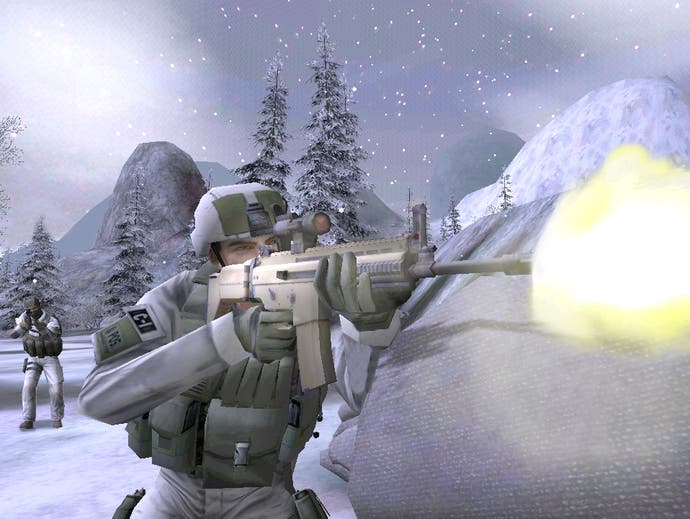
In what amounts to a full-on action game, Summit Strike simply issues a series of clear mission objectives that most gamers will be familiar with. You're never in any doubt over what to do or where to go, with an excellent overhead map allowing you to not only pinpoint your units but also where you are in precise relation to your next target. As such, the game is never a complex one, but no less satisfying because of it. While the objectives generally fall into the category of either a) blowing stuff up, or b) killing everything in sight, what makes the game a relentlessly compelling prospect is that the immediacy of the combat.
An enemy encounter is never far away in Summit Strike, but you're rarely unhappy about that thanks to some generally excellent mission design, allied to solid AI routines and a well honed control/camera system. A typical mission might involve killing more than 80 enemies, but in the main those encounters are measured, with clusters of foes emerging from multiple directions to really hammer home the fact that you're out in the open. Unlike most games that only dish out enemies in front of you, you'll often find yourself in Summit Strike battling off enemies that have not only managed to outflank you but also taken you by surprise.
It's not all uniform greatness, though. Much like many other squad-based games, enemies still have a tendency to rush at you with scant regard for their own safety. Some make a cursory attempt to duck and cover, with the odd foe prepared to pop out from behind cover, but that's the exception rather than the rule.
Spawny gits
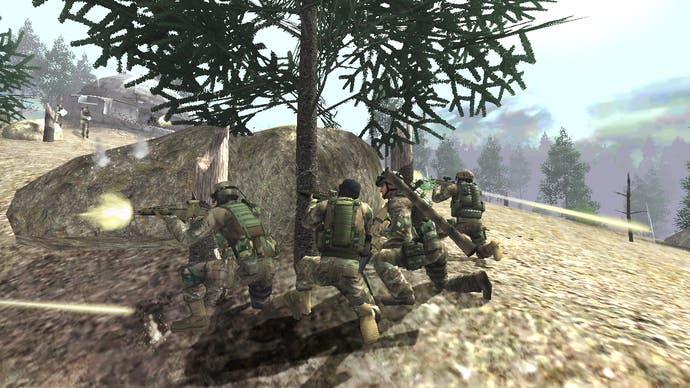
In general, the open-ended mission design allows players a small amount of freedom towards a linear goal, but does have a tendency to trip itself off on occasion. In one mission you have the option to approach a factory complex from two different directions. Take the more direct route and the odds seem utterly overwhelming. Seemingly no matter how many enemies you eliminate, they just keep on a-coming. And so it goes on. You inch your way into the complex, trying your best to flush them out, but more appear - to the point where they literally start appearing spontaneously in front of you, just ten feet away. Aha, it's a spawn point.
Now, this was odd when we played it, as up to then it'd seemed that Ubi's game design didn't utilise respawning enemies at all. Yet here it was, and we could repeat the trick to order. As it happened, the only way to stop this evil endless respawning was to enter the factory via the other entrance, trigger the appearance of a tank, blow that up with some Satchel Charges and secure the compound that way. Gah.
How much of this respawning nonsense actually goes on in the game isn't clear, but it certainly took the shine off our enjoyment a little until we discovered a workaround. On later levels it wasn't as apparent - but a lot of that has to do with the fact that you're often traversing wide open spaces, and Ubi can easily drop in new enemies as and when it feels like it, and still make it feel convincing. But if any of the Ubi team is reading this - please, design levels that have a set number of enemies to kill; don't just spirit them into play out of thin air. If there's anything guaranteed to kill the sense of immersion and shatter our sense of disbelief, it's that.
Take the weather with you
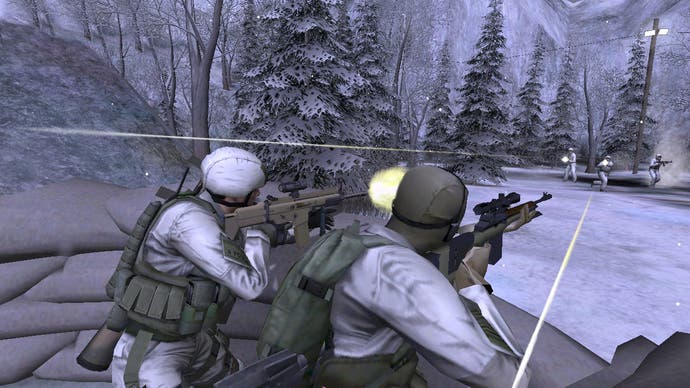
Fortunately though, incidents such as this are mercifully rare, and for the vast majority of the time, you get to enjoy a tense and satisfying romp through all manner of terrains and climates; from the chilling snow-capped Kazakhstani mountains to rolling grassy hills and urban warfare, from clear daytime sunshine to night time sorties and rain-drenched hell.
Much of the game's enjoyment stems from the sheer base simplicity of the combat, which in itself comes from a mixture of fluid controls, sensible choices of viewpoint and some basic rules that other games choose to ignore. The game's default over-the-shoulder viewpoint offers a pseudo first-person feel that grants almost as much precision as if you were controlling it that way. A quick click on the right thumb-stick zooms into a scoped view, letting you take out pesky enemies from a distance, and a general solidity and responsiveness of control makes it easy to pull off headshots with precision. Unlike many over-sensitive dual analogue-focused games, Ubi pitches the dead zone at precisely the right level so that you're never overshooting the reticule and aren't left cursing the lack of auto-target.
Amazingly, it's one of the few games around where camera issues simply don't exist. Whether it's the fact that it's all outdoors, or uses an over-the-shoulder view we're not entirely sure. But whatever Ubi's doing, it works, and works well. Other developers, take note.
Healthy option

Another crucial secret of Summit Strike's success is a wonderfully sensible approach to health. Essentially a slight variation on R6's, you have to pay close attention to your health as well as that of your squad-mates. With no health packs to pick up, your only clue is the colour of your health status, as well as the pained noises you emit when you've copped some lead. The hideous, fleshy 'thunk' noise of a bullet tearing into your flesh, followed by extensive heavy breathing tells you all you need to know about getting out of the line of enemy fire. Take too many, and you'll slump to the ground and be forced to re-load - but it's a tense system that works far better than consuming 21 health packs a la Conflict.
You can, though, tell your other squaddies to heal your downed team-mate, albeit once per level. Should they cop it, they're gone for the remainder of the level, though do magically reappear for the next mission. Incapacitated indeed.
An area that Ubi definitely deserves maximum respect is the visuals. Considering how tough it has been for developers to render expansive outdoor environments on consoles (even PCs, come to think of it) over the years, this is damn near the best you'll ever see on humble home system. Evidently, the sheer size of the levels and the challenges that enormous draw distances present limit the spectacle to an extent (it's no Splinter Cell, for a start), but even so - it's a stunning looking game. Stand it next to a Conflict game (even Global Storm) and you'll be impressed at just how much more Ubi squeeze out of the box.
Slick
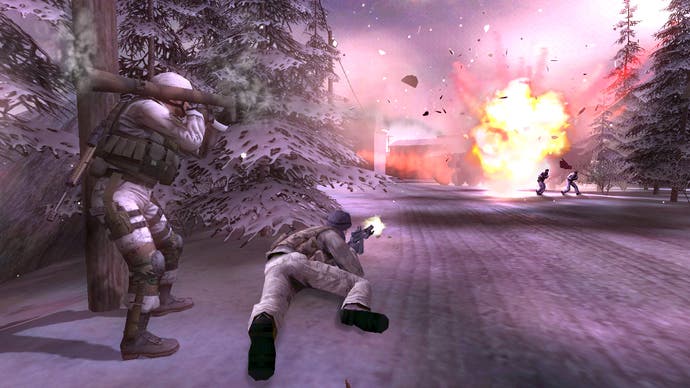
And it's not simply that the levels look better, with improved texturing, more impressive explosions, interesting and exceptionally varied terrain. The thing that continues to impress us about the Ghost Recon 2 games is the fantastically slick animation routines. What's really impressive isn't so much the movement, but the transition of movements, making any and every action (just check out the reloading, for one thing) look about as natural as any game around at the moment. As a finishing touch, even the detail on the characters is worthy of applause. All round, it's simply a great-looking game.
The 11 single player missions might not be exactly innovative in terms of what you're actually tasked with pulling off, but they'll keep you going for a fair amount of time. It was rare for us to crack a mission in less than an hour, and it was one of the few games of this type that we're truly grateful for the ability to quick-save (and unlike Rainbow Six Lockdown, you can reload quickly and easily, so no complaints there). 10 to 12 hours of entertainment for a game that you can buy today for £12.99? Sounds like the sort of value all publishers should be offering whenever they palm us off with an annual update masquerading as a 'sequel'. Added to the main campaign dish are a bunch of other 'Quick Mission' single-player modes to jump into whenever you feel like it, such as Defend (fight off oncoming waves of enemies), Firefight (take everyone out on the map), Lone Wolf (play a campaign mission on your own), Recon (don't alert enemy soldiers while taking on a series of objectives), and Heli Hunt (fight off choppers swarming your way). Good, freebie extras. No complaints there.
If that was all there was to Summit Strike, that would be good enough on its own. The fact that Ubi then chucks in 24 multiplayer modes just serves to illustrate the exceptional value that this tidy little package offers. Playable over split-screen (up to 4), System Link or online over Xbox Live, there a simply too many to mention within the bounds of a conventional review, but can be basically broken down into three distinct categories: co-op (nine modes), solo (five modes) and squad modes (ten modes).
More more more
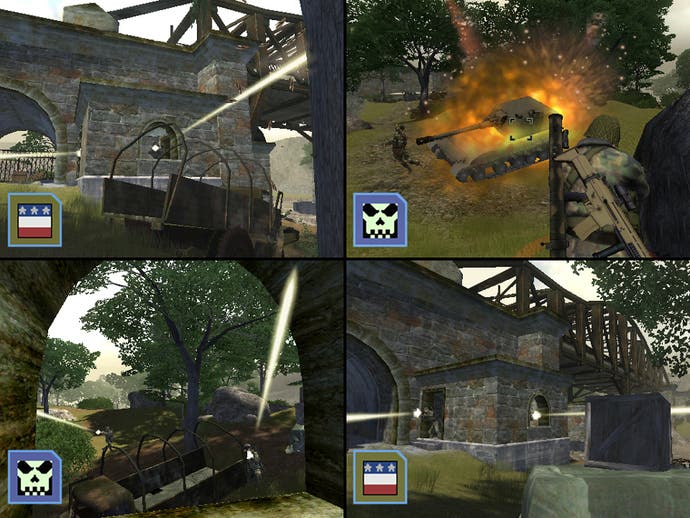
As well as being able to play all of the standard missions in co-op (very highly recommended), Summit Strike offers all the standard variations on classic game modes such as deathmatch, last man standing, domination, capture the flag, and so on. Perhaps the most interesting modes (because we prefer teamwork than just shooting each other), though, are the various co-op modes, where a myriad of options enable you to set up a huge variety of different matches that encompass straight up squad-based kill fests, defending a base, taking out choppers, as well as objective-based mission-style modes. And not only are there a mind-boggling number of modes, but a healthy 25 maps to enjoy too. Although it wasn't possible to test every single map and mode, it's safe to suggest that it's an Xbox Live title that's going to keep people amused for months on end. Better still, you can even play Xbox Live with four-player split-screen, with all of you duking it out online at once. Nice touch. The fact that it's a largely lag-free and smooth experience makes it even better.
Considering Summit Strike is only pitched as a budget-priced expansion pack to last year's 'full-blown' version, Ubisoft has done an exceptional job of providing nigh-on top draw entertainment with literally no compromises. Sure, it may be a couple of missions short of what most games of this ilk offer, but for the price you won't be complaining. Whether you're here for the single-player campaign or fancy engaging in some of the best Xbox Live entertainment around, Summit Strike thumbs its nose at the very concept of the full priced release in offering exceptional value for money. For the price, you'd be mad to miss out.

